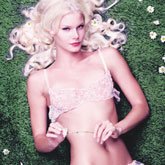London Museum Highlights the Evolution of Underwear
Underneath defining paradigm shifts in clothing is a foundation of lingerie that molds the body into that desired silhouette. Christian Dior’s structured “New Look” couldn’t have been achieved without corselettes and girdles that exaggerated a pinched waist and an ample bosom. Dior’s historical innerwear—along with contemporary designs from La Perla, Myla and Stella McCartney—will be on display at the Fashion and Textile Museum in London as part of an exhibit that explores lingerie’s changing shape throughout the decades. The exhibit, titled “Undercover: The Evolution of Underwear,” will run from June 12 to Sept. 27.
Curator Alison McCann begins the lingerie timeline at the turn of the century and sets the stage for when Mary Phelps Jacob, who later changed her name to Caresse Crosby, patented the first bra in 1915. This was during World War I, when materials were becoming scarce. “The resources going into the corset manufacture were in decline, so they had to look at other methods of undercover. hellip; A bra is far more cost-effective to produce than a corset,” McCann said.
McCann has worked on the merchandising and product-development side of the lingerie business for 14 years for brands such as Pleasure State, The Berlei Group and Calvin Klein Underwear. Now as a curator, she reflects on lingerie’s technical construction in relationship to the cultural landmarks that dictated the changing fashions.
Lingerie construction is explored through themes such as “enhancement,” “control” and “research and innovation.”
Sizeable real estate in the exhibition is given to lingerie’s latest growth spurt, from the 1980s to today. McCann said the ’80s is her favorite decade because it’s when women started to embrace lingerie again. “It’s no longer something that’s bought for them for a special occasion,” she said. “They have now got disposable incomes and can actually buy what they want. I think lingerie design [during this time] specifically focused on women wearing lingerie every day.”
European and Australian brands— including Triumph, La Perla, Rigby & Peller and Myla—lead in representation. The American contingent is a mix of start-up brands and the big guns—including Victoria’s Secret, Calvin Klein Underwear, Wonderbra, hip New York–based brand The Lake & Stars and Spanx shapewear—that cover both functionality and fashion.
“Now there isn’t one particular style or shape that is the real defining thing,” McCann said of the contemporary lingerie featured. “It’s about bra wardrobing: having the right bra for the right outfit. It can be the case of having five bras in your wardrobe to accommodate the shape changes.”
Los Angeles–based Carol Malony’s items—both bedroom theatrical and practical—earned a spot in the “Boudoir to Everyday Glamour” section. “They’re coquettish and fun and feminine, but it’s something that women wear for themselves as well as for their partner,” McCann said.
Celebrities and films throughout the decades that have impacted the way women are featured wearing lingerie, as well. One of the first “Merry Widow” corselettes by Warners (circa 1956) will be on display. The style was made famous by the 1952 film of the same name, starring Lana Turner. In a perfect illustration of retro meets contemporary, the museum will show a selection of lingerie from the collection of modern burlesque dancer Dita von Teese. —Rhea Cortado
























